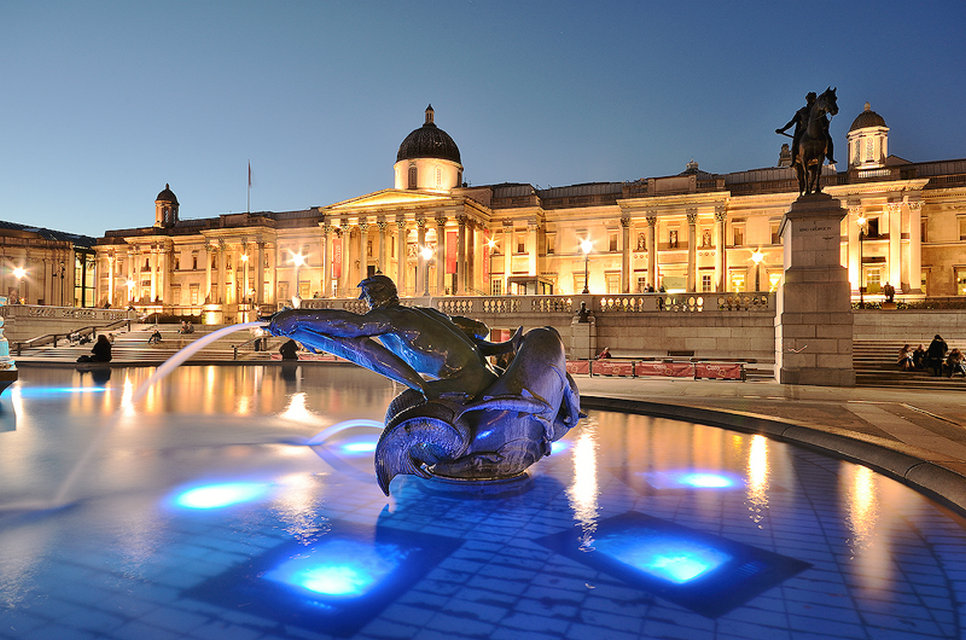The National Gallery, London, United Kingdom


The National Gallery is an art museum in Trafalgar Square in the City of Westminster, in Central London. Founded in 1824, it houses a collection of over 2,300 paintings dating from the mid-13th century to 1900. The Gallery is an exempt charity, and a non-departmental public body of the Department for Culture, Media and Sport. Its collection belongs to the public of the United Kingdom and entry to the main collection is free of charge. It is among the most visited art museums in the world, after the Musée du Louvre, the British Museum, and the Metropolitan Museum of Art.
Unlike comparable museums in continental Europe, the National Gallery was not formed by nationalising an existing royal or princely art collection. It came into being when the British government bought 38 paintings from the heirs of John Julius Angerstein, an insurance broker and patron of the arts, in 1824. After that initial purchase the Gallery was shaped mainly by its early directors, notably Sir Charles Lock Eastlake, and by private donations, which comprise two-thirds of the collection. The resulting collection is small in size, compared with many European national galleries, but encyclopaedic in scope; most major developments in Western painting “from Giotto to Cézanne” are represented with important works. It used to be claimed that this was one of the few national galleries that had all its works on permanent exhibition.
The National Gallery Collection contains over 2,300 works, including many famous works, such as van Eyck’s ‘Arnolfini Portrait’, Velázquez’s ‘Rokeby Venus’, Turner’s ‘Fighting Temeraire’ and Van Gogh’s ‘Sunflowers’.
All major traditions of Western European painting are represented from the artists of late medieval and Renaissance Italy to the French Impressionists.
– 13th- to 15th-century paintings: Duccio, Uccello, van Eyck, Lippi, Mantegna, Botticelli, Dürer, Memling, Bellini
– 16th-century paintings: Leonardo, Cranach, Michelangelo, Raphael, Holbein, Bruegel, Bronzino, Titian, Veronese
– 17th-century paintings: Caravaggio, Rubens, Poussin, Van Dyck, Velázquez, Claude, Rembrandt, Cuyp, Vermeer
– 18th- to early 20th-century paintings: Canaletto, Goya, Turner, Constable, Ingres, Degas, Cézanne, Monet, Van Gogh
In the 20th century the Gallery’s late Victorian interiors fell out of fashion. The Crace ceiling decorations in the entrance hall were not to the taste of the director Charles Holmes, and were obliterated by white paint. The North Galleries, which opened to the public in 1975, marked the arrival of modernist architecture at the National Gallery. In the older rooms, the original classical details were effaced by partitions, daises and suspended roofs, the aim being to create neutral settings which did not distract from contemplation of the paintings. But the Gallery’s commitment to modernism was short-lived: by the 1980s Victorian style was no longer considered anathema, and a restoration programme began to restore the 19th- and early-20th-century interiors to their purported original appearance. This began with the refurbishment of the Barry Rooms in 1985–6. From 1996 to 1999 even the North Galleries, by then considered to “lack a positive architectural character” were remodelled in a classical style, albeit a simplified one.
Since 1989, the gallery has run a scheme that gives a studio to contemporary artists to create work based on the permanent collection. They usually hold the position of associate artist for two years and are given an exhibition in the National Gallery at the end of their tenure.
The respective remits of the National and Tate Galleries, which had long been contested by the two institutions, were more clearly defined in 1996. 1900 was established as the cut-off point for paintings in the National Gallery, and in 1997 more than 60 post-1900 paintings from the collection were given to the Tate on a long-term loan, in return for works by Gauguin and others. However, future expansion of the National Gallery may yet see the return of 20th-century paintings to its walls.